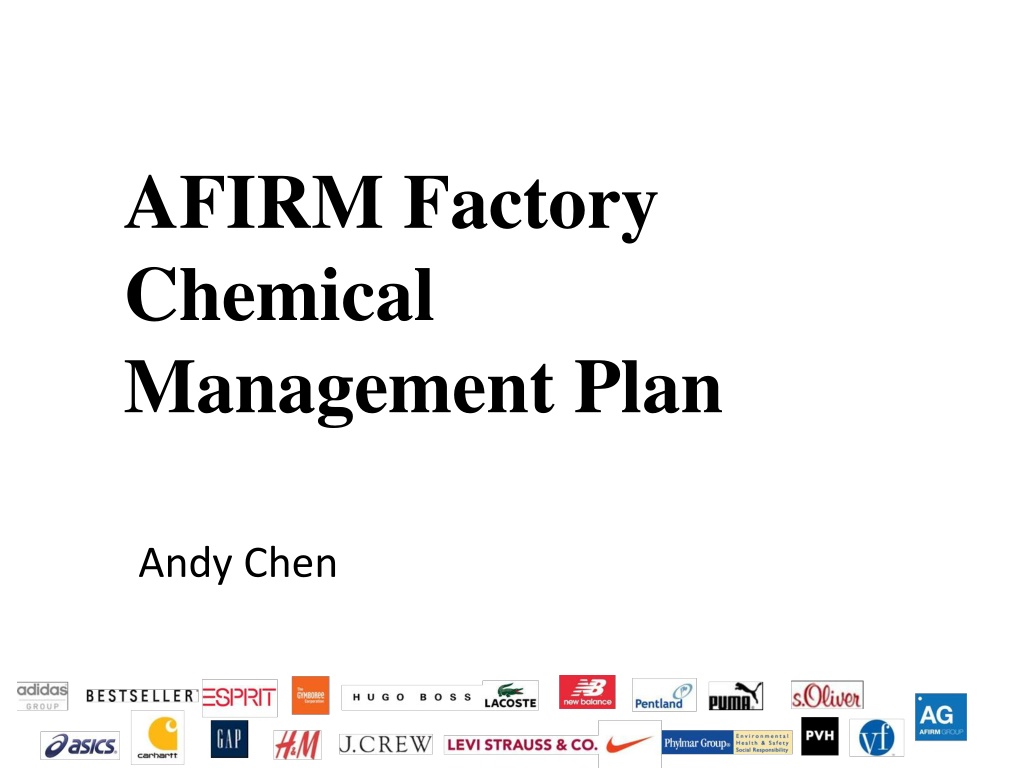
Effective RSL Management Strategies for Factories
This detailed plan outlines essential strategies for managing Restricted Substances List (RSL) compliance in factories, including team roles, supplier engagement, risk prioritization, legislative considerations, testing approaches, and short and long-term goals. It emphasizes the importance of understanding RSL requirements, implementing efficient testing processes, and establishing vendor management protocols to ensure compliance and minimize risks associated with chemicals in products.
Download Presentation

Please find below an Image/Link to download the presentation.
The content on the website is provided AS IS for your information and personal use only. It may not be sold, licensed, or shared on other websites without obtaining consent from the author. Download presentation by click this link. If you encounter any issues during the download, it is possible that the publisher has removed the file from their server.
E N D
Presentation Transcript
AFIRM Factory Chemical Management Plan Andy Chen
Factory Management Put together a RSL Project Team Assign: * Roles * Responsibilities 2
RSL Strategy for Components and Suppliers Know your business Specifically include RSL compliance in the contract List vendors for components and suppliers List type of materials, components and source from each vendor listed above 3
Understand your RSL Requirements Describe your overall management strategy to minimize RSL risk Focus on High Risk Materials High Risk colors 4
Legislation REACH - CPSIA - China RSL Design Production Final Product 5
Implementation - Sample Testing Approach Target high risk materials Prioritize Kids Products Prioritize Direct Skin Contact Randomly check anything Sample selection rules based on how a material is used Engage factory and vendor 6
Short Term Goals Identify RSL risk by material Set up the RSL risk control strategy Develop tracking report/system. All the RSL test results are reported to management on a seasonal basis. 7
Long Term Goals Create an evaluation system to track vendor compliance. A score card could be established and implemented Use the result of evaluation for the future sourcing decisions Share the RSL database with vendors 8
Vendor Management Describe your management strategy to minimize risk from vendors Classify vendors by RSL risk Define a low risk vendor Define a high-risk vendor Ensure that new vendors understand and meet the RSL 9
Chemical Testing The best way to manage the RSL is to be knowledgeable about product chemistry 10
Build Knowledge Understand the process and chemicals involved in the manufacture of the components, for example by checking the MSDS Use the RSL risk identification database Test components prior to confirmation 11
Corrective Action The cause(s) of individual failures can be varied Root cause analysis (PDCA) should determine how to best reduce risk of RSL violation A Failure Resolution Form should be used as a tool for tracking 13
Non-compliance under production Stop production Replace with complying materials Destroy non-compliant materials Vendor to reimburse on all losses 14
Data Management Access to RSL data throughout the supply chain is a key component in management strategy for the RSL Checking list: Have a database for all testing data Send RSL data for management review on a regular basis Identify suppliers with repeated failures and stop the PO 15
Use Safer Phthalate Alternatives Safer Phthalate Alternatives The following substances have been identified as examples of safer alternatives by the U.S. Environmental Protection Agency and/or by the Danish Environmental Protection Agency. They may be suitable for your production needs. 77-90-7 Acetyl tributyl citrate (ATBC) 6422-86-2 Bis(2-ethylhexyl) terephthalate (DEHT/DOTP) 103-23-1 Di(ethylhexyl) adipate (DEHA) 166412-78-8, 47919-59-0 Diisononyl cyclohexane-1,2-dicarboxylate (DINCH) 122-62-3 Dioctyl sebacate (DIDS) 3319-31-1 Trioctyl trimetallitate (TOTM) 6846-50-0 Trimethyl pentanyl diisobutyrate (TXIB) Additional information about these alternatives is available at the following links: http://www.epa.gov/opptintr/existingchemicals/pubs/actionplans/phthalates_actionplan_revised_2012-03-14.pdf http://www2.mst.dk/udgiv/publications/2010/978-87-92708-00-7/pdf/978-87-92708-01-4.pdf http://www.greenchemistryandcommerce.org/documents/PilotProjectFullReportOct2-final_000.pdf 18
/ (ATBC) (2- ) (DEHT/DOTP) (2- ) (DEHA) 77-90-7 6422-86-2 103-23-1 166412-78-8 47919- 59-0 122-62-3 3319-31-1 6846-50-0 1 2- (DINCH) (DIDS) (TOTM) 2,2,4- -1,3- (TXIB) http://www.epa.gov/opptintr/existingchemicals/pubs/actionplans/phthalates_actionplan _revised_2012-03-14.pdf http://www2.mst.dk/udgiv/publications/2010/978-87-92708-00-7/pdf/978-87-92708-01- 4.pdf 19
Thank You 20
